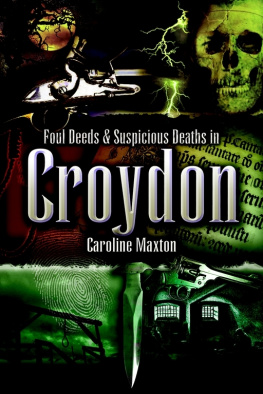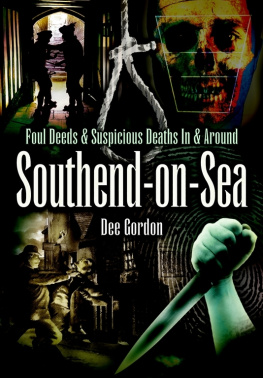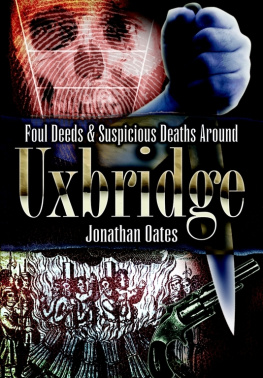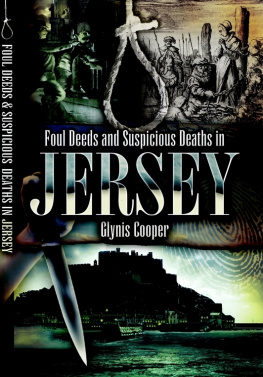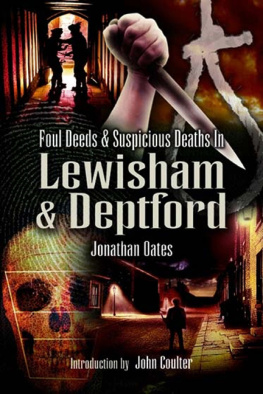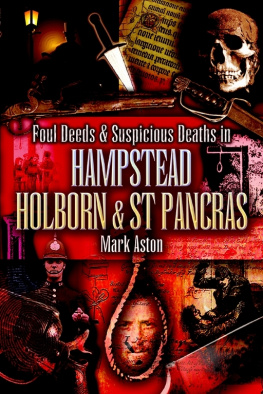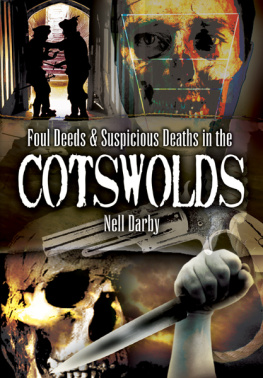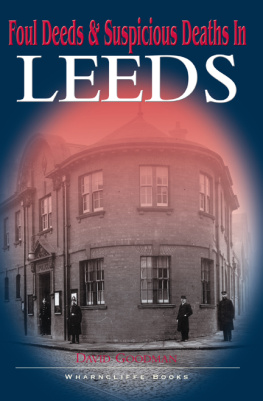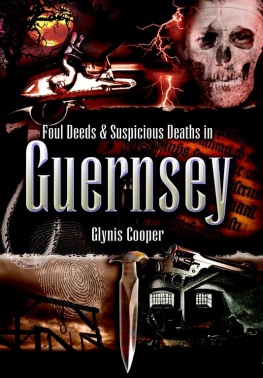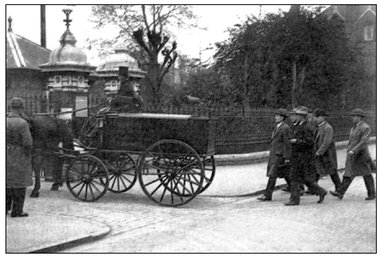It is impossible to complete the research for a book like this without a great deal of help. I am indebted to the staff of various research centres, including the British Library and the National Archives. But my special thanks go to the staff of the Croydon Local Studies Library, not only for their patience and efficiency, but for going to extraordinary lengths to help with all my enquiries, sometimes providing the answer before Id even managed to work out the question!
And then there are the many individuals who helped along the way. My thanks go to Jim Brown for providing technical know-how for the illustrations; to Dr Malcolm Cooper, Mary and Richard Mobbs and Norah Adams for their sharp eyes in reading the manuscript, and for knowing just how to turn a phrase to make it right; to Louise Ferns, Sarah Lott and Marion Brown for all their hard work and enthusiasm in the research; and to Robert Grant for finding George Guy, John OLeary and many of the photographs, for his insight in reading the manuscript, but most of all for keeping the smile on my face.
Select Bibliography
Anon., A Letter To Mr Sanxay (1775)
Anon., The Life and Trial of Jane Butterfield (1775)
Bentley, Iris, Let Him Have Justice (1995)
Bentley, W G, My Sons Execution (1957)
Berry-Dee, C and Robin Odell, Dad Help Me Please (1990)
Croydon Oral History Society, Talking of Croydon (1990)
Dickens, Charles, Our Mutual Friend (1864 5)
Du Cann, C G L, Miscarriages of Justice (1960)
Gaute, J H H and Robin Odell, The Murderers Whos Who (1979)
Hall, J G and G D Smith, The Croydon Arsenic Mystery (1999)
Honeycombe, Gordon, The Murders of the Black Museum (1982)
Janaway, John, Surrey Murders (1988)
Johnson, W H, Surrey Villains (2004)
McInnes, Paula and Bill Sparkes, The Croydon Workhouse (no date)
Morland, Nigel, Background to Murder (1955)
Murder Casebook, The Croydon Poisonings (1991)
Murder Casebook, Too Young to be Hanged (1996)
Paget, Clarence G, By-ways in the History of Croydon (1929)
Parris, John, Scapegoat (1991)
Philip, Neil and Victor Neuburg (eds), Charles Dickens: A December Vision (1986)
Pritchard, R E, Dickenss England (2002)
Selwyn, Francis, Nothing But Revenge (1991)
Stewart, Frances, Around Haunted Croydon (1989)
Trow, M J, Let Him Have It Chris (1990)
Wheatley, Dennis, Drink and Ink (1979)
Whittington-Egan, Richard, The Riddle of Birdhurst Rise (1975)
Yallop, David, To Encourage the Others (1990)
CHAPTER 1
The Birdhurst Rise Mysteries: Edmund Duff, 1928 Vera and Violet Sidney, 1929
Who can say who did it?
U nder the cover of darkness, two bodies were exhumed from the Queens Road Cemetery, Croydon. The press had been following this particular case closely, and police wished to remove the bodies to the mortuary at Mayday Hospital before news of the exhumations broke. Standing at the graveside was Tom Sidney, and it fell to him to identify the bodies of his mother, Violet, and his sister, Vera, by the light of the hurricane lamps. It was March 1929.
Less than eight weeks later, on 18 May, Tom was back at the cemetery in the early hours of the morning to identify his brother-in-law, Edmund Duff. But this time he was called on to do nothing more than confirm the nameplate on the coffin. The police were opening an investigation into three separate deaths that had occurred within one family in the space of eleven months and there were whispered rumours of murder.
Although not conspicuously wealthy, the Sidney family had lived quite comfortably. Sixty-eight-year-old Violet was the widow of Thomas Sidney, an eminent barrister, and she lived with her forty-year-old spinster daughter, Vera, at 29 Birdhurst Rise, South Croydon. It was a Victorian house, generous in size and graceful in appearance, and properly reflected the respectability of its occupants. Violets other two children, Tom and Grace, lived nearby. It was a close family, drawn closer still by the departure of their father, Thomas Sidney, who ran off to India with his brothers sister-in-law. It was not the first of his affairs and Violets anger at her husbands infidelity burned brightly for the remainder of her life.
On their fathers death in 1917 Grace, Vera and Tom received absolutely nothing from his will, but his passing meant they were now each entitled to 5,000 from a legacy set up by their paternal grandfather. Thomas Sidney might have fallen short in his duties as a father, but before his death he did one thing that had a great impact on Graces life he introduced her to her future husband.
Transfer of Edmund Duffs body following exhumation. Second from the left of the group following the hearse is Tom Sidney. Hulton Picture Library
Thomas Sidney had met Edmund Duff in India, and they struck up an easy friendship that continued after their return to England. When Thomas introduced Duff to his twenty-three-year-old daughter in 1909 he had no idea that they would marry two years later. It was a seemingly happy marriage. Grace and Edmund had five children together, although they suffered the sadness of losing two of them in infancy. Not everyone approved of the union, however. Edmund was seventeen years older than Grace, not good with money and was disapproved of by Violet. She always found it difficult to accept into her family a man who was a close friend of the husband who had abandoned her.
Edmund Duff worked in the Colonial Service, and later for the Ministry of Pensions, but had lost his post by the mid-1920s. Although he earned relatively small sums from a clerical job and from writing articles and short stories, the shortage of money in the Duff branch of the family became yet another issue of which Violet disapproved. Grace herself took a more philosophical approach: what they lacked in prosperity they made up for in family affection, and the odd threadbare patch in their home at 16 South Park Road was overlooked.
On 26 April 1928 Edmund came home from a short fishing trip in Fordingbridge, Hampshire. He generally enjoyed good health, but on the journey back had started to feel unwell: he was shivering and slightly feverish, but Grace was not unduly concerned. Like many other normally robust people, Edmund tended to exaggerate any minor ailments, and besides he looked quite well. Grace and the children had already eaten, but there was a meal of chicken and potatoes and Edmunds favourite beer waiting for him on his return. He ate very little of the food, but drank the beer. Later that evening he began to feel worse, and so Grace called Dr Robert Elwell to see her husband. There was nothing obviously amiss other than a slightly raised temperature and nausea. The doctor recommended taking aspirin and quinine, and as much rest as possible.
By morning Edmund was worse: he complained of a sore throat, vomiting and diarrhoea. Dr Elwell was called again, and at about noon his partner, Dr John Binning, came to examine the patient. Again there was no obvious diagnosis. Edmund Duff had a stomach upset, that much was clear, but it seemed nothing out of the ordinary. Dr Binning prescribed calomel and took his leave, confident that Edmunds discomfort would soon pass.
In the afternoon the continuing vomiting and diarrhoea were accompanied by severe abdominal pains, and by the time Dr Elwell called back to see his patient later in the afternoon, Edmund was in a seriously weakened state. The doctor was still at a loss to explain the cause of these symptoms, other than assuming that Edmund must have eaten something that disagreed with him. Dr Binning took his turn to visit Edmund in the early evening and saw a marked deterioration in his condition. The stomach cramps were now agonizing and Edmund was too light-headed to stand unaided. He lay in his bed shivering in a cold sweat. For the first time, Dr Binning considered the possibility that the condition might be fatal, and telephoned Dr Elwell to communicate his concerns. When Grace called the surgery again that night to tell them that Edmund had difficulty in breathing, both doctors attended him. They administered whatever they could to ease his pain but shortly after eleven oclock Edmund Duff died, leaving a near-hysterical widow and an unanswered mystery.

